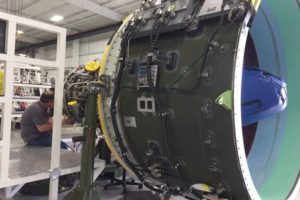
By Lawrence Specker
Being picked as one of IndustryWeek’s best plants of 2016 didn’t come as a complete surprise to leaders at UTC Aerospace in Foley.
“It is a tremendous deal for us. But really it shows what we all had known,” said General Manager Darrell B. Wilson. “We knew we were the best plant. The world knows it now.”
Closer to home, the award is a reminder that the Gulf Coast aerospace industry involves a lot more than the new Airbus assembly facility in Mobile that has gotten so much attention over the last year. UTC has been operating in the area since the ’80s. Like other companies, it’s benefiting from new Airbus deals, but it was well established long before the industry giant decided to plant its flag in Lower Alabama.
Since 1990, according to IndustryWeek, the publication has held an annual search for “manufacturing facilities that are delivering truly exceptional performances, that are improving customer satisfaction, that are growing their competitiveness, that are creating stimulating and rewarding work environments.” The half-dozen plants chosen in 2016 include operations from Mexico to Michigan, making everything from batteries to threaded pipe products. (Stories on them will appear in the March/April issue of IndustryWeek, and will appear online at the same time.)
What they have in common, according to IndustryWeek, is that they show “show enviable performances across quality, safety and productivity. They demonstrate industry-leading cycle times. They simply work smarter.”
In the main hall on the original equipment (OE) side of UTC’s Foley operation, big digital clocks high on the wall are a sign of the emphasis on time. One reads 25,200. Another reads 6,300.
“There are about 25,200 seconds available to work in a day,” said Wilson. “We think in seconds.”
If a particular flow line has to produce four completed assemblies a day, that works out to one unit completed every 6,300 seconds. Which means everybody on the line is doing his or her task to that tempo. “Every 6,300 seconds, something needs to roll off this line into the paint shop,” said Wilson.
It sounds like a recipe for stress and frenzy, yet on a recent weekday tour of the facility, neither was in evidence. Workers had an air of focus and deliberation, but not haste. No one seemed to be standing around waiting on anyone else to finish up; no one was wandering around looking for missing tools or colleagues.
Wilson explained that the focus on seconds is more about looking for inefficiencies that cost seconds, and finding ways to eliminate them. Save enough seconds and you’ve saved a minute; save enough minutes and you’ve saved an hour. “Support cells” along the lines are kiosks where supervisors stay close to the work, so anyone with a question doesn’t have to go hunting through an office suite to find someone with an answer. At other stations, workers assemble small parts and hardware into kits, so that assemblers have everything ready to hand when it’s time to work on a new unit.
On the OE side, the units are engines and the pods that house them as they hang under a wing. The workers in Foley build up the inlet cowls, fan cowls and thrust reversers – “everything that wraps around the engine,” as Operations Manager Don Chesscher puts it – and then install them on the engines.
It’s called Engine Build Up, and the Foley plant does it for every Airbus A321 coming out of the Airbus Final Assembly Line (FAL) in Mobile. But they also do it for Boeing and Bombardier. And they’re building a major new addition so they can do even more of it in the future, mainly for the Airbus A320neo program.
Some numbers: UTC owns four 40-acre industrial parcels close to the Foley Municipal Airport, so it has plenty of room to grow. Its OE manufacturing operations currently enclose about 230,000 square feet, with the addition bringing another 80,000. The other side of the business, the maintenance, repair and overhaul (MRO) facility, encloses 210,000 square feet.
650 people work on the OE side, 221 on the MRO side. They’ll gradually hire about 200 more as the current round of expansion continues through the next couple of years. “We are Baldwin County’s largest manufacturing employer,” said Wilson.
The MRO side of the plant has a different feel. The jobs are just as exacting, but every one is different. Lori Gillette, the general manager of UTC’s MRO Americas operation, said the Foley site services parts from planes in use all over North and South America. The site does specialize in engine nacelles, but also works on some other components, she said.
“We have about 78 different customers that send work through our shop,” said Gillette. “Some of the airlines have decided their core competency is flying the people, not repairing the components … The majority of them do outsource this kind of work.”
Gillette said that a small portion the work is incident-related – for example, an inlet cowl damaged by a bird impact. But 85 percent of it addresses routine wear and tear, with a goal of bringing components back to like-new condition. During a tour, Gillette pointed out that one of the projects on hand was a unit that had originally been built in Foley, the thrust reverser off a Boeing 717 (formerly known as the McDonnell-Douglas MD-95). Production of those jets ended in 2006. The kind of MRO work done in Foley helps keep them – and much older aircraft – in service. Annual sales are about $80 million, Gillette said.
Other corners of the operation include a paint shop, a bond shop for high-tech composite fabrication and even a showroom, where folks from the Airbus FAL in Mobile can come and scope out a completed pair of engine units before they’re carted over to Mobile on a specially designed truck.
Daryl Taylor, vice president and general manager of the Airbus U.S. manufacturing facility, said that the Foley plant’s role is extensive. It “pods” all the CFM56 and V2500 engines used by the Mobile FAL, paints the nacelles so they’re ready to hang and provides on-site support. The plant makes the thrust reversers for all the VF2500 engines used by Airbus.
“It’s certainly a proud day when the hard work your teams are performing every day is recognized outside the organization,” Taylor said of the IndustryWeek honor for Foley. “Congratulations to the team in UTAS-Foley for their hard work.”
UTC, like the FAL, is part of an operation with global scope. Parent company UTC’s major divisions are Otis, the elevator company; UTC Climate, Controls & Security; Pratt & Whitney, the jet engine manufacturer; and UTC Aerospace Systems (UTAS). UTAS, in turn, has multiple divisions and boasts that its products “are on board almost everything that flies.” Aside from Foley, its Aerostructures OE business has facilities in California, Texas, Florida, Mexico and Canada. The Foley plant even makes parts that it ships to sister operations in France and Germany, for other assembly lines serving Airbus plants.
It’s been a long, steady development for the Foley plant to get to this point. Human Resources Manager Linda Howser said that some of the plant’s leaders, including Wilson, Chesscher and Finance Manager Michael Welsh, started out as assemblers.
“We were actually building components for planes that had propellers,” Welsh said of the plant’s early days.
“It’s the people here,” said Wilson of the plant’s success. “It’s the philosophy.”
Howser said part of that philosophy is that UTC doesn’t just like to promote from within – it likes to give its workers the support they need to become candidates for promotion. One significant perk is that the company pays for continuing education.
“We have 55 people currently enrolled in school, working on their degrees,” Howser said. That’s more than eight percent of the workforce, about one out of every dozen people. According to information provided by the company, UTC overall has spent more than $1.2 billion on employees’ formal education, and employees have earned more than 38,500 degrees in more than 60 countries since 1996.
The future seems promising. As production continues to ramp up at the Airbus FAL in Mobile, the demand for engine assemblies from Foley steadily increases. And for a factory that has seen planes come and go, the rise of the A320neo program means the beginning of a long, long run of work.
“This thing’s going to be built for 25-30 years,” said Welsh.
The new building going up now isn’t being built on a hunch. It’s a reflection of established demand, and the Foley plant’s history of meeting it.
“We’re going to fill it up real quick,” said Welsh. “We’ve got to have the space. We’ve got to have more people.”
Source: http://www.al.com/


















